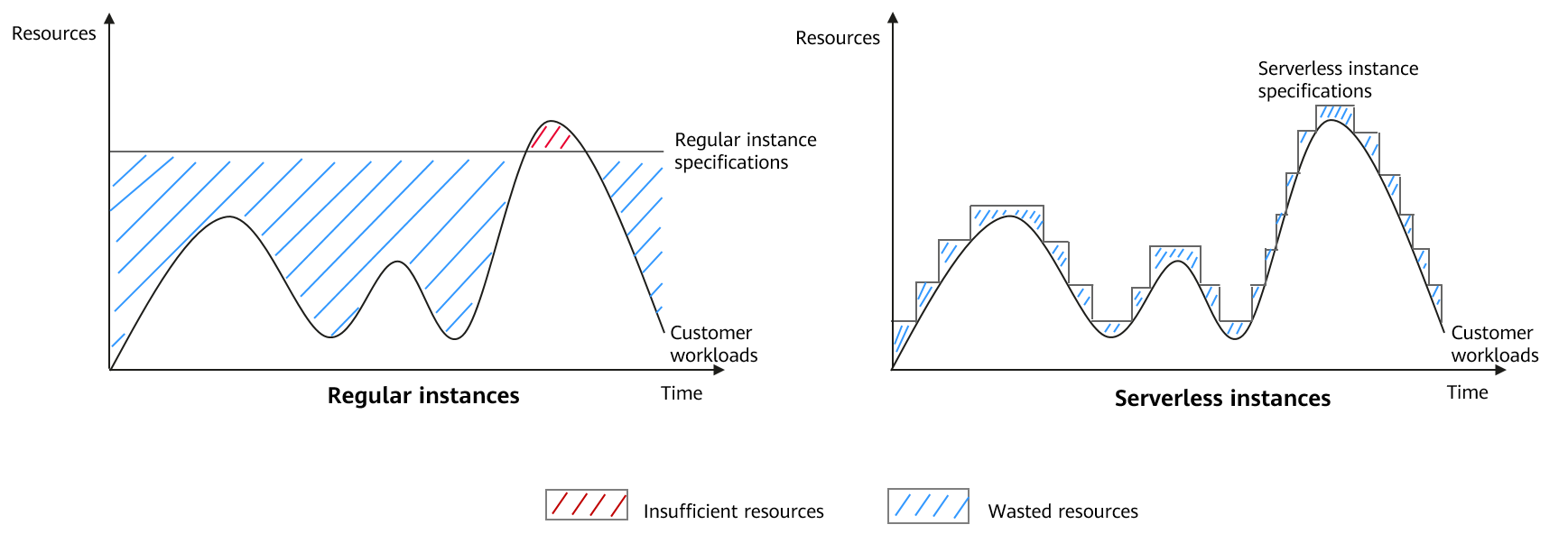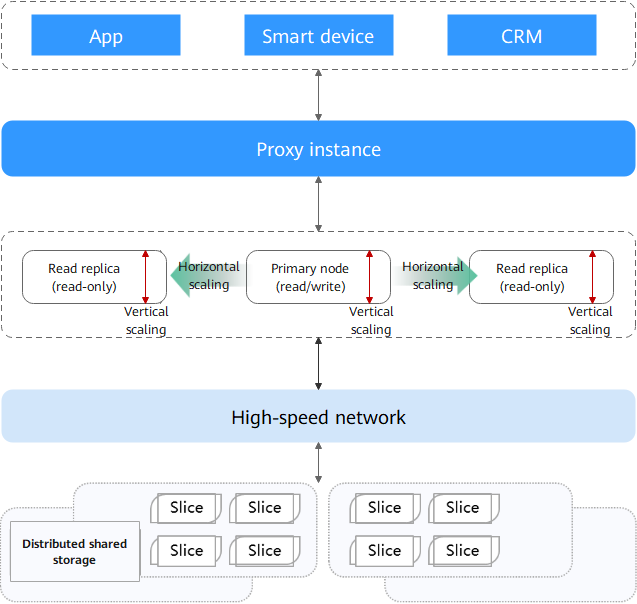O que é uma instância sem servidor?
Contexto
A estabilidade e a confiabilidade dos bancos de dados são cruciais para sistemas de TI de nível empresarial. Se um banco de dados não for estável, o sistema inteiro não poderá ser executado corretamente. Para garantir uma operação tranquila do banco de dados durante os horários de pico, os usuários geralmente configuram vários parâmetros e recursos redundantes (como computação, memória e armazenamento).
No entanto, durante os horários de pico, esses recursos redundantes geralmente ficam ociosos, resultando em custos desperdiçados. Mesmo com essas configurações, ainda existe o risco de escassez temporária de recursos em face de picos inesperados nas cargas de trabalho, o que pode comprometer o sistema geral.
Além dos usuários empresariais típicos, há também muitos usuários que ocasionalmente usam bancos de dados de pequena escala apenas para desenvolvimento e teste, desenvolvimento de miniaplicativos e ensino em laboratório escolar. Esses usuários geralmente têm requisitos mínimos de especificação, mas exigem continuidade da carga de trabalho. A criação ou exclusão constante de instâncias de pagamento por uso não é viável, e a compra de instâncias anuais/mensais de baixa especificação resulta em um desperdício significativo de dinheiro quando não há cargas de trabalho para processar.
Para resolver essas preocupações, o TaurusDB introduziu instâncias sem servidor. Essas instâncias podem ajustar recursos dinamicamente com base em cargas de trabalho e são cobradas de acordo com o uso, ajudando os clientes a acelerar o processamento de dados a custos mais baixos. Além disso, instâncias sem servidor facilitam o uso de bancos de dados em nuvem por empresas de pequeno e médio porte.
A figura a seguir mostra o uso de recursos e as alterações de especificação de instâncias regulares e sem servidor durante flutuações significativas de carga de trabalho.

Conforme mostrado na figura, as instâncias regulares e sem servidor têm desempenho diferente durante flutuações significativas de carga de trabalho.
- Instâncias regulares: os recursos são desperdiçados fora do horário de pico e insuficientes durante o horário de pico, o que afetará as cargas de trabalho.
- Instâncias sem servidor: as especificações são ajustadas com base nas demandas de carga de trabalho para atingir o mínimo de desperdício de recursos. Mesmo durante os horários de pico, as demandas de carga de trabalho ainda podem ser atendidas, garantindo a continuidade da carga de trabalho e melhorando a estabilidade do sistema.
Como funciona uma instância sem servidor
As instâncias sem servidor do TaurusDB usam uma arquitetura de gravação única e leitura múltipla (WORM) e armazenamento compartilhado. Elas oferecem a capacidade de dimensionar dinamicamente com as cargas de trabalho do sistema. Cada nó de instância pode dimensionar verticalmente CPUs e memória em segundos e dimensionar horizontalmente réplicas de leitura. Isso significa que a computação pode se adaptar de forma rápida e independente aos picos e vales, alcançando alta relação custo-benefício.

- Tanto o nó primário quanto as réplicas de leitura são sem servidor. Eles usam armazenamento compartilhado distribuído e podem ser dimensionados com base nas alterações da carga de trabalho.
- A unidade de cobrança é a Unidade de capacidade do TaurusDB (TCU). 1 TCU é aproximadamente igual a 1 CPU e 2 GB de memória. Quando o nó primário ou uma réplica de leitura é dimensionado, suas TCUs aumentam ou diminuem de acordo.
- Ao criar uma instância sem servidor, você pode especificar um intervalo de TCU, em vez de configurar especificações específicas. Em seguida, a instância pode ser dimensionada com base no uso da CPU e no uso da memória.
Vertical scaling: o desempenho do nó (especificações de CPU e memória) muda.
O Cloud Eye monitora o uso da CPU e o uso da memória de instâncias sem servidor. Se alguma das seguintes condições for atendida, uma expansão será acionada automaticamente:
- O uso da CPU é maior que 80% por 5 segundos e se passaram pelo menos 5 segundos desde a última expansão.
- O uso de memória é maior que 80% por 5 segundos e se passaram pelo menos 5 segundos desde a última expansão.
- O uso da CPU é superior a 60% por 20 segundos e se passaram pelo menos 10 segundos desde a última expansão.
Se a seguinte condição for atendida, uma redução será acionada automaticamente:
O uso da CPU é inferior a 30% por 15 segundos e se passaram pelo menos 15 segundos desde a última redução.
Horizontal scaling: o número de alterações de réplicas de leitura.
Se a computação já tiver sido ampliada o máximo possível, mas o uso da CPU ou da memória ainda atender a uma condição de expansão da computação, réplicas de leitura serão adicionadas.
Se a computação já tiver sido reduzida o máximo possível, mas o uso da CPU ou da memória ainda atender a uma condição de redução da computação, as réplicas de leitura serão removidas.
Cobrança
Para obter detalhes, consulte Cobrança sem servidor.
Vantagens
- Custo mais baixo: as instâncias sem servidor do TaurusDB não dependem de outra infraestrutura ou serviços relacionados. Elas podem ser usadas imediatamente e fornecem serviços de acesso a dados estáveis e eficientes. Você só é cobrado pelos recursos que usa.
- Maior espaço de armazenamento: o espaço de armazenamento de uma instância sem servidor pode chegar a até 32.000 GB. Ele pode aumentar a escala se o volume de dados da instância aumentar, evitando impactos nas cargas de trabalho devido a recursos de armazenamento insuficientes.
- Dimensionamento automático de recursos computacionais: os recursos de computação necessários para operações de leitura e gravação podem ser dimensionados de forma flexível, reduzindo consideravelmente os custos de O&M e os riscos do sistema.
- Experiência totalmente gerenciada e sem O&M: todas as tarefas de O&M, como dimensionamento de especificações, dimensionamento automático de armazenamento, monitoramento e alarmes e O&M inteligente, são concluídas pelas equipes profissionais da Huawei Cloud, proporcionando uma experiência verdadeiramente livre de O&M. Você nem vai notar, e suas cargas de trabalho não serão afetadas.
Casos de uso
- Os bancos de dados são usados com pouca frequência, como para testes corporativos e desenvolvedores individuais.
- Existem tarefas programadas intermitentes a serem executadas, como estatísticas e arquivamento de dados, ensino escolar e tarefas de P&D.
- Existem flutuações imprevisíveis nas cargas de trabalho, como check-in e computação de borda.
- É necessária uma experiência sem O&M ou um banco de dados totalmente gerenciado.
- Os custos do banco de dados precisam ser reduzidos fora do horário de pico.






